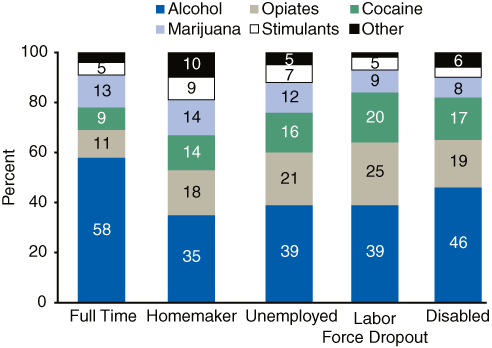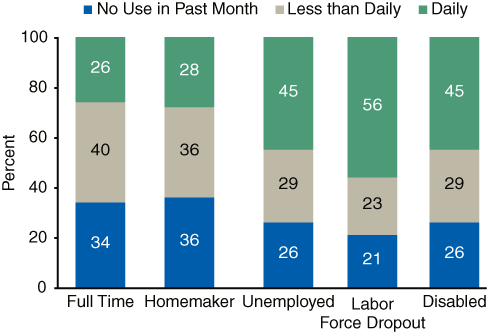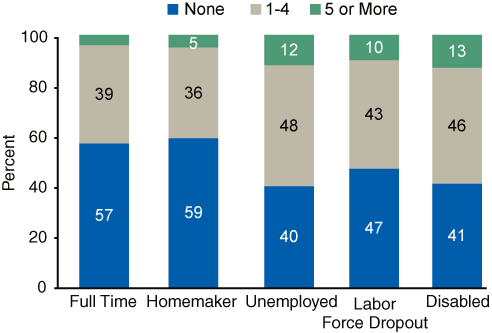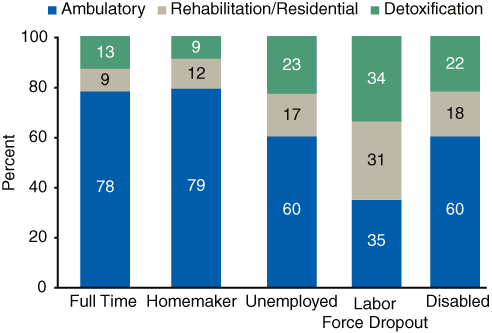
 |
March 20, 2008 |
|
Employment is among the best predictors of successful substance abuse treatment.1 It is also considered an important measure of success in substance abuse treatment: “increased employment” is one of the desired outcomes in the Substance Abuse and Mental Health Services Administration’s National Outcome Measures (NOMs) framework.2 Thus, employment status is relevant both to substance abuse treatment outcomes and policymaking.
The employment status of admissions to substance abuse treatment can be examined with the Treatment Episode Data Set (TEDS), an annual compilation of data on the demographic characteristics and substance abuse problems of those admitted to substance abuse treatment, primarily at facilities that receive some public funding.3 TEDS records represent admissions rather than individuals, as a person may be admitted to treatment more than once during a single year.
This report focuses on substance abuse treatment admissions aged 18 to 64, the age group that is typically expected to be in the labor force. In 2006, 31 percent of substance abuse treatment admissions aged 18 to 64 were employed, 33 percent were unemployed, and 36 percent were not in the labor force (i.e., not employed and not looking for work). In comparison, 75 percent of noninstitutionalized civilians in the United States aged 18 to 64 were employed in 2006, 3 percent were unemployed, and 22 percent were not in the labor force.4
TEDS substance abuse treatment admissions classified as “not in labor force” are both numerous and diverse; they can be examined in more detail with the TEDS Supplemental Data Set. In 2006, 31 States or jurisdictions reported detailed “not in labor force” status.5 Among admissions aged 18 to 64 who reported that they were not in the labor force in these States, 22 percent were disabled, 7 percent were inmates of institutions, 5 percent were students, 3 percent were homemakers, and 2 percent were retired. The remaining 61 percent were not in the labor force for other reasons, and will be referred to here as “labor force dropouts.”
This report compares substance abuse treatment admissions aged 18 to 64 in five employment status groups: full-time employed, unemployed, and three not-in-labor-force groups—labor force dropouts, disabled, and homemakers. Altogether, these groups comprise over 86 percent of the admissions in the 31 States reporting detailed not-in-labor-force information in 2006.6
In 2006, admissions to substance abuse treatment varied by employment group in their primary substance of abuse.7 While alcohol was the most frequently reported primary substance for each employment group, admissions who were employed full time were more likely to report alcohol as the primary substance of abuse (58 percent) than admissions who were homemakers (35 percent), unemployed (39 percent), labor force dropouts (39 percent), or disabled (46 percent) (Figure 1).
On the other hand, admissions who were unemployed, labor force dropouts, or disabled were about twice as likely as admissions who were employed full time to report opiates (21, 25, or 19 percent vs. 11 percent) or cocaine (16, 20, or 17 percent vs. 9 percent) as their primary substance of abuse. Admissions who were homemakers were more likely than other admissions to report primary stimulant abuse (9 percent vs. 4 to 7 percent among the other groups).
 |
Source: 2006 SAMHSA Treatment Episode Data Set (TEDS). |
| Primary Substance of Abuse | Full Time | Homemaker | Unemployed | Labor Force Dropout | Disabled |
|---|---|---|---|---|---|
| Alcohol | 58% | 35% | 39% | 39% | 46% |
| Opiates | 11% | 18% | 21% | 25% | 19% |
| Cocaine | 9% | 14% | 16% | 20% | 17% |
| Marijuana | 13% | 14% | 12% | 9% | 8% |
| Stimulants | 5% | 9% | 7% | 5% | 4% |
| Other | 4% | 10% | 5% | 2% | 6% |
Source: 2006 SAMHSA Treatment Episode Data Set (TEDS). |
In 2006, substance abuse treatment admissions who were unemployed, labor force dropouts, or disabled were more likely than admissions who were employed full time or who were homemakers to report daily use of the primary substance of abuse. For example, admissions who were labor force dropouts were more than twice as likely as admissions who were employed full time to report daily use of their primary substance in the past month (56 vs. 26 percent) (Figure 2). Admissions who were unemployed or labor force dropouts were less likely than admissions who were employed full time or who were homemakers to report no use in the past month. For example, admissions who were unemployed (26 percent) were less likely than admissions who were employed full time (34 percent) to report no use of the primary substance in the past month. These overall patterns held true regardless of primary substance of abuse.8
 |
Source: 2006 SAMHSA Treatment Episode Data Set (TEDS). |
| Frequency of Use | Full Time | Homemaker | Unemployed | Labor Force Dropout | Disabled |
|---|---|---|---|---|---|
| No Use in Past Month | 34% | 36% | 26% | 21% | 26% |
| Less than Daily | 40% | 36% | 29% | 23% | 29% |
| Daily | 26% | 28% | 45% | 56% | 45% |
Source: 2006 SAMHSA Treatment Episode Data Set (TEDS). |
In 2006, admissions who were homemakers or who were employed full time were more likely to report entering treatment for the first time (59 and 57 percent, respectively) than admissions who were unemployed (40 percent), labor force dropouts (47 percent), or disabled (41 percent) (Figure 3). Substance abuse treatment admissions who were unemployed or disabled were more likely than other admissions to report five or more prior treatment episodes.
 |
Source: 2006 SAMHSA Treatment Episode Data Set (TEDS). |
| Number of Prior Treatment Episodes | Full Time | Homemaker | Unemployed | Labor Force Dropout | Disabled |
|---|---|---|---|---|---|
| None | 57% | 59% | 40% | 47% | 41% |
| 1-4 | 39% | 36% | 48% | 43% | 46% |
| 5 or More | 4% | 5% | 12% | 10% | 13% |
Source: 2006 SAMHSA Treatment Episode Data Set (TEDS). |
Substance abuse treatment admissions who were unemployed, labor force dropouts, or disabled were more likely than admissions who were employed full time or who were homemakers to be in detoxification service settings and less likely to be in ambulatory treatment in 2006 (Figure 4).9 Admissions who were labor force dropouts were more likely than admissions in any of the other employment groups to be in rehabilitation/residential service settings (31 percent vs. 9 to 18 percent among the other groups).
 |
Source: 2006 SAMHSA Treatment Episode Data Set (TEDS). |
| Service Setting | Full Time | Homemaker | Unemployed | Labor Force Dropout | Disabled |
|---|---|---|---|---|---|
| Ambulatory | 78% | 79% | 60% | 35% | 60% |
| Rehabilitation/ Residential |
9% | 12% | 17% | 31% | 18% |
| Detoxification | 13% | 9% | 23% | 34% | 22% |
Source: 2006 SAMHSA Treatment Episode Data Set (TEDS). |
1 Substance Abuse and Mental Health Services Administration, Center for Substance Abuse Treatment. (2000). Executive summary and recommendations. TIP 38: Integrating substance abuse treatment and vocational services (DHHS Publication No. SMA-00-3470). Rockville, MD. Retrieved June 22, 2007, from http://www.ncbi.nlm.nih.gov/books/bv.fcgi?rid=hstat5.section.68391
2 National Outcome Measures (NOMs). (n.d.). Retrieved February 12, 2008, from http://www.nationaloutcomemeasures.samhsa.gov/outcome/index.asp
3 In 2006, TEDS collected data on 1.8 million admissions to substance abuse treatment facilities. Four States and jurisdictions (AK, DC, GA, and VT) did not submit data for 2006.
4 Calculated using seasonally unadjusted 2006 annual data compiled by the U.S. Department of Labor, Bureau of Labor Statistics, through the
Labor Force Statistics from the Current Population Survey tool. Retrieved January 28, 2008, from http://data.bls.gov/PDQ/outside.jsp?survey=ln
5 Detailed “not in labor force” is a Supplemental Data Set item. The 31 States and jurisdictions in which it was reported for at least 75 percent of all applicable admissions in 2006—AR, AZ, CO, DE, HI, IA, KS, KY, LA, MD, ME, MN, ND, NH, NJ, NM, NY, OH, OR, PA, PR, RI, SC, SD, TN, TX, UT, VA, WA, WV, and WY—accounted for 62 percent of substance abuse admissions in 2006.
6 The employment groups distinguished by TEDS but not included in this report are those with substantial proportions outside the 18 to 64 age range focus of this report (students, retired persons, part-time employed), or groups that are excluded from the labor force by definition (inmates).
7 The primary substance of abuse is the main substance reported at the time of admission.
8 A single exception was found for disabled primary opiate admissions, which were slightly less likely to report daily use than their full-time employed counterparts.
9 Service settings are of three types: ambulatory, rehabilitation/residential, and detoxification. Ambulatory settings include intensive outpatient, non-intensive outpatient, and ambulatory detoxification. Rehabilitation/residential settings include hospital (other than detoxification), short-term (30 days or fewer), and long-term (more than 30 days). Detoxification includes 24-hour hospital inpatient and 24-hour free-standing residential.
Substance Abuse and Mental Health Services Administration, Office of Applied Studies. (March 20, 2008). The DASIS Report - - Employment Status and Substance Abuse Treatment Admissions: 2006. Rockville, MD.
| The Drug and
Alcohol Services Information System (DASIS) is an integrated data
system maintained by the Office of Applied Studies, Substance Abuse and
Mental Health Services Administration (SAMHSA). One component of DASIS
is the Treatment Episode Data Set (TEDS). TEDS is a compilation of data
on the demographic characteristics and substance abuse problems of
those admitted for substance abuse treatment. The information comes
primarily from facilities that receive some public funding. Information
on treatment admissions is routinely collected by State administrative
systems and then submitted to SAMHSA in a standard format. TEDS records
represent admissions rather than individuals, as a person may be
admitted to treatment more than once. State admission data are reported
to TEDS by the Single State Agencies (SSAs) for substance abuse
treatment. There are significant differences among State data
collection systems. Sources of State variation include completeness of
reporting, facilities reporting TEDS data, clients included, and
treatment resources available. See the annual TEDS reports for details.
Approximately 1.8 million records are included in TEDS each year. The DASIS Report is prepared by the Office of Applied Studies, SAMHSA; Synectics for Management Decisions, Inc., Arlington, Virginia; and by RTI International in Research Triangle Park, North Carolina (RTI International is a trade name of Research Triangle Institute). Information and data for this issue are based on data reported to TEDS through October 9, 2007. Access the latest TEDS reports
at: |
The DASIS Report is published periodically by the Office of Applied Studies, Substance Abuse and Mental Health Services Administration (SAMHSA). All material appearing in this report is in the public domain and may be reproduced or copied without permission from SAMHSA. Additional copies of this report or other reports from the Office of Applied Studies are available online: http://oas.samhsa.gov. Citation of the source is appreciated. For questions about this report please e-mail: shortreports@samhsa.hhs.gov |
|
This page was last updated on December 30, 2008. |
|
SAMHSA, an agency in the Department of Health and Human Services, is the Federal Government's lead agency for improving the quality and availability of substance abuse prevention, addiction treatment, and mental health services in the United States. 
* PDF formatted files require that Adobe Acrobat Reader® program is installed on your computer. Click here to download this FREE software now from Adobe. |